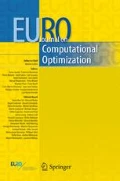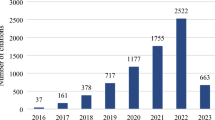Abstract
We discuss an application of the well-known multiplicative weights update (MWU) algorithm to non-convex and mixed-integer non-linear programming. We present applications to: (a) the distance geometry problem, which arises in the positioning of mobile sensors and in protein conformation; (b) a hydro unit commitment problem arising in the energy industry, and (c) a class of Markowitz’ portfolio selection problems. The interest of the MWU with respect to one of its closest competitors (classic multi-start) is that it provides a relative approximation guarantee on a certain quality measure of the solution.





Similar content being viewed by others
Notes
An exact reformulation (formally defined in Liberti 2009 as a surjective mapping from the optima of the exact reformulation to the optima of the original problem) is not the same as an exact pointwise reformulation. Intuitively speaking, solving an exact reformulation of a problem directly yields a solution of the problem itself, which is not generally the case for an exact pointwise reformulation.
References
Arora S, Hazan E, Kale S (2005) Fast algorithms for approximate semidefinite programming using the multiplicative weights update method. In: Foundations of Computer Science, vol 46. FOCS, IEEE, New York, pp 339–348
Arora S, Hazan E, Kale S (2012) The multiplicative weights update method: a meta-algorithm and applications. Theory Comput 8:121–164
Bahr A, Leonard J, Fallon M (2009) Cooperative localization for autonomous underwater vehicles. Int J Robot Res 28(6):714–728
Beasley JE (1990) OR-Library: distributing test problems by electronic mail. J Oper Res Soc 41(11):1069–1072
Beasley JE (1996) Obtaining test problems via internet. J Glob Optim 8(4):429–433
Beeker N, Gaubert S, Glusa C, Liberti L (2013) Is the distance geometry problem in NP? In: Mucherino A, Lavor C, Liberti L, Maculan N (eds) Distance geometry: theory, methods, and applications. Springer, New York
Berman H, Westbrook J, Feng Z, Gilliland G, Bhat T, Weissig H, Shindyalov IN, Bourne P (2000) The protein data bank. Nucl Acid Res 28:235–242
Bienstock D (1996) Computational study of a family of mixed-integer quadratic programming problems. Math Program 74(2):121–140
Bonami P, Lee J (2007) BONMIN user’s manual. Technical report, IBM Corporation
Bonami P, Lee J, Leyffer S, Waecher A (2011) More Branch-and-Bound experiments in convex nonlinear integer programming. Preprint ANL/MCS-P1949-0911. Argonne National Laboratory, Mathematics and Computer Science Division
Borghetti A, D’Ambrosio C, Lodi A, Martello S (2015) Optimal scheduling of a multiunit hydro power station in a short-term planning horizon. In: Murty KG (ed) Case studies in operations research. International series in operations research & management science, vol 212, pp 167–181. Springer, New York
Boyd S, Vandenberghe L (2004) Convex optimization. Cambridge University Press, Cambridge
Chang T-J, Meade N, Beasley JE, Sharaiha YM (2000) Heuristics for cardinality constrained portfolio optimization. Comput Oper Res 27(13):1271–1302
COIN-OR (2006) Introduction to IPOPT: a tutorial for downloading, installing, and using IPOPT
Costa A, Hansen P, Liberti L (2010) Formulation symmetries incircle packing. In: Mahjoub R (ed) Proceedings of the international symposium on combinatorial optimization. Electronic notes in discrete mathematics, vol 36. Elsevier, Amsterdam, pp 1303–1310
D’Ambrosio C, Ky Vu, Lavor C, Liberti L, Maculan N (2014) Solving distance geometry problems with interval data using formulation-based methods. Technical report, LIX Ecole Polytechnique (working paper)
D’Ambrosio C, Mencarelli L (2014) Complex portfolio selection via convex mixed-integer quadratic approaches: a survey. Technical report, LIX, École Polytechnique (working paper)
Ding Y, Krislock N, Qian J, Wolkowicz H (2010) Sensor network localization, Euclidean distance matrix completions, and graph realization. Optim Eng 11:45–66
Du H, Alechina N, Stock K, Jackson M (2013) The logic of NEAR andFAR. In: Tenbrink T et al (ed) COSIT. LNCS, vol 8116. Springer, Switzerland, pp 475–494
Fischetti M, Lodi A (2003) Local branching. Math Program Ser B 98(1–3):23–47
Frangioni A, Gentile C (2006) Perspective cuts for a class of convex 0–1 mixed integer programs. Math Program Ser A 106(2):225–236
Gupta OK, Ravindran A (1985) Branch-and-Bound experiments in convex nonlinear integer programming. Manag Sci 31(12):1533–1546
Hansen P, Mladenović N (2001) Variable neighbourhood search: principles and applications. Eur J Oper Res 130:449–467
IBM (2010) ILOG CPLEX 12.2 User’s Manual, IBM
Kannan R, Monma CL (1978) On the computational complexity of integer programming problems. In: Henn R, Korte B, Oettli W (eds) Optimization and operations research. Lecture notes in economics and mathematical systems, vol 157, pp 161–172. Springer, Berlin
Konno H, Wijayanayake A (2001) Portfolio optimization problem under concave transaction costs and minimal transaction unit constraints. Math Program Ser B 89(2):233–250
Lavor C, Liberti L, Maculan N (2006) Computational experience with the molecular distance geometry problem. In: Pintér J (ed) Global optimization: scientific and engineering case studies. Springer, Berlin, pp 213–225
Liberti L (2009) Reformulations in mathematical programming: definitions and systematics. RAIRO-RO 43(1):55–86
Liberti L, Lavor C, Maculan N, Mucherino A (2014) Euclidean distance geometry and applications. SIAM Rev 56(1):3–69
Malliavin T, Mucherino A, Nilges M (2013) Distance geometry in structural biology. In: Mucherino A, Lavor C, Liberti L, Maculan N (eds) Distance geometry: theory, methods, and applications. Springer, New York
Maniezzo V, Stützle T, Voß S (eds) (2009) Hybridizing metaheuristics and mathematical programming. Annals of information systems, vol 10. Springer, New York
Markowitz HM (1952) Portfolio selection. J Finan 7(1):77–91
Plotkin S, Shmoys D, Tardos É (1995) Fast approximation algorithm for fractional packing and covering problems. Math Oper Res 20:257–301
Saxe J (1979) Embeddability of weighted graphs in \(k\)-space is strongly NP-hard. In: Proceedings of 17th Allerton conference in communications, control and computing, pp 480–489
Scherer B, Martin D (2005) Introduction to modern portfolio optimization. Springer, Berlin
Schlick T (2002) Molecular modelling and simulation: an interdisciplinary guide. Springer, New York
Shaw DK, Liu S, Kopman L (2008) Lagrangian relaxation procedure for cardinality-constrained portfolio optimization. Optim Methods Softw 23(3):411–420
Singer A (2011) Angular synchronization by eigenvectors and semidefinite programming. Appl Comput Harmonic Anal 30:20–36
Sun X, Zheng X, Li D (2013) Recent advances in mathematical programming with semi-continuous variables and cardinality constraint. J Oper Res Soc China 1(1):55–77
Tahanan M, van Ackooij W, Frangioni A, Lacalandra F (2015) Large-scale unit commitment under uncertainty: a literature survey. 4OR 13:115–171
Xue H-G, Xu G-X, Feng Z-X (2006) Mean-variance portfolio optimal problem under concave transaction cost. Appl Math Comput 174(1):1–12
Acknowledgments
We are very grateful to Dr. Pascale Bendotti (EDF) for useful suggestions about the HUC problem. Luca Mencarelli is sponsored by a Ph.D. Fellowship from the FP7 Marie Curie ITN “MINO” project. Youcef Sahraoui is sponsored by a CIFRE Ph.D. Fellowship with Éléctricité De France (EDF). Leo Liberti was partly sponsored by the ANR Bip:Bip project under contract ANR-10-BINF-0003, and completed this work during a visiting term at IMECC, University of Campinas (SP), Brazil, sponsored by the Chaires Françaises dans l’état de São Paulo (CFSP) program, a collaboration between the French Consulate in São Paulo, and the three main universities in São Paulo: UNICAMP, USP, and UNESP.
Author information
Authors and Affiliations
Corresponding author
Appendices
Appendix 1: Parameter values for the HUC instances
See Table 8.
Appendix 2: Detailed results for the MVPS problem
Tables 9, 10, 11, 12 and 13 report the numeric results for each transaction cost function. Their columns are as follows:
-
instance name;
-
maximum risk level \(\sigma \);
-
number n of assets quoted on the financial market;
-
objective value for the MWU algorithm;
-
CPU time (in seconds) for the MWU algorithm;
-
objective value for the MWU algorithm with the local branching constraint;
-
CPU time (in seconds) for the MWU algorithm with the local branching constraint;
-
objective value for the MS algorithm with the local branching constraint;
-
CPU time (in seconds) for the MS algorithm with the local branching constraint;
-
relative objective value improvement from MS to MWU computed as
$$\begin{aligned} \Gamma = \frac{{\textsf {val}}({\textsf {MWU}})-{\textsf {val}}({\textsf {MS}})}{|{\textsf {val}}({\textsf {MS}})|}; \end{aligned}$$(7.1) -
time improvement ratio \(\Lambda \) from MS to MWU (see Eq. (4.2));
-
relative objective value improvement from MS to MWU with the local branching constraint (see Eq. (7.1));
-
time improvement ratio \(\Lambda \) from MS to MWU with the local branching constraint (see Eq. (4.2)).
The comparison metrics are summarized in the last three lines with the sum (\(\sum \)), average (avg), and the standard deviation (std) across all 20 instances.
Rights and permissions
About this article
Cite this article
Mencarelli, L., Sahraoui, Y. & Liberti, L. A multiplicative weights update algorithm for MINLP. EURO J Comput Optim 5, 31–86 (2017). https://doi.org/10.1007/s13675-016-0069-8
Received:
Accepted:
Published:
Issue Date:
DOI: https://doi.org/10.1007/s13675-016-0069-8




